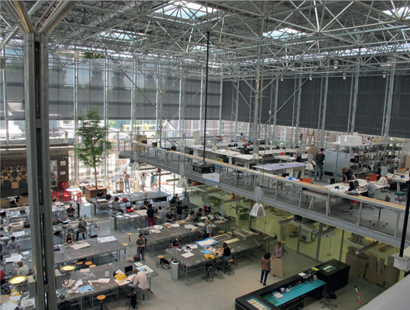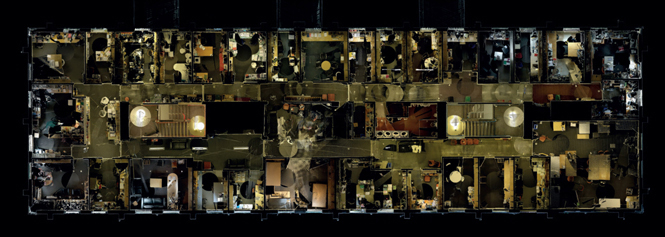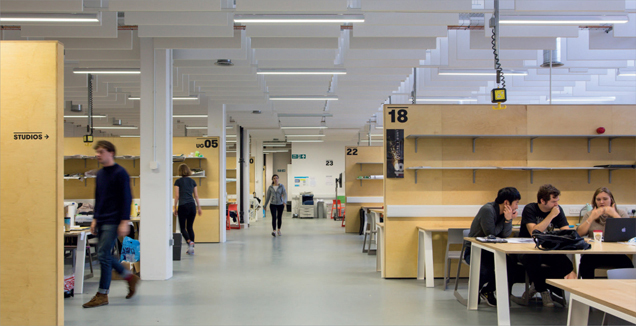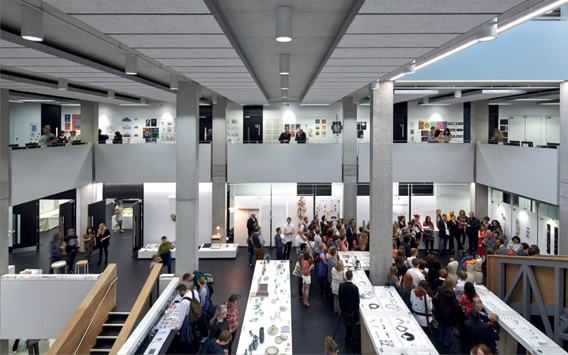Creative Design Studios
Fostering a Creative Culture
Studios should foster inspiration, creation and exploration of ideas, debate and exhibition. A good studio culture is important to stimulate debate and critical thinking. Allowing students to express their ideas and to ‘own’ their space is important. However, studio space is at a premium with student numbers increasing and courses competing for limited resources, so justifying providing students with dedicated studio space is going to be an increasing challenge.
We need to re-think how we provide these spaces so that we create an open studio culture where spaces can be appropriated and shared by students without losing the benefits. The challenge is to support studio identity without creating ‘silos’, which can make studios insular.
Allowing a suitable framework or ‘scenery’ for the students and tutors to make the space their own but not so bespoke as to make it unique is the key factor. This openness and cross-fertilisation of ideas better reflects the collaborative working practices within the creative industries.
Robust finishes are important, as they allow for change and minimise maintenance but also reinforce the idea that these spaces are experimental and help promote the creative and often messy work as students explore materiality and form.
An open-plan 6m x 6m grid with break-out spaces on each floor allows for each unit to reconfigure layouts according to their diverse range of needs.
Example
Tu Delft MVRDV
A centralised shared model-making suite is at the heart of the main atrium en-route to the café; highly visible to building users/visitors creating an engaging shop front to the work of the faculty. Specialist/noisy equipment is contained in glazed rooms; more general model-making is in the atrium space.

Figure 2.45
Example
Bartlett School of Architecture UCL
A strong unit-based culture is being given a new home; one which aims to foster dialogue between units. The original 1960s cellular building, is characterised by long corridors, is being extensively remodelled and extended.

Figures 2.46 and 2.47
Existing spaces

Figure 2.48
Image created from a 3D scan of the space at the Bartlett School of Architecture UCL

Figure 2.49
The ideas for the new studios have been tested in the temporary fit-out for its decant space in a large warehouse on Hampstead Road, allowing experimentation in terms of subdivision, storage servicing and space

Figures 2.50 A and B
The result of this process has informed the approach to furniture and transparency. Studios are open to the circulation space; staff are interspersed throughout the studios. As the floor plan and image (below) illustrate, social spacesocial spaces double as exhibition areas; engagement is encouraged by hosting crits adjacent to breakout areas
Shared Resources
Multi-use of space and zoning of activities based on public, privileged or private uses can allow many activities to co-exist with higher utilisation, but this also requires greater management.
If we can stop thinking of spaces as being departmental, free of any territorial restrictions, this can provide huge opportunities for shared resources. This needs to evolve out of agreement of how spaces will be managed. Co-location of resources with other specialist disciplines can bring benefits in terms of shared use of spaces/equipment and this can in turn encourage exploration of new materials/techniques and dialogue and skills shared between different disciplines.
Example
Large Permeable Open Studios and Shared Workshops
University of the Arts London, Stanton Williams workshops (see right) are not department based and students are encouraged to explore new materials. Time slots are negotiated with primary users gaining priority access. Open studios help foster collaboration both between students and disciplines.

Figure 2.51

Figure 2.52
Manchester School of Art, Feilden Clegg Bradley Studios

Figure 2.53
School of Architecture Cornell, OMA
Technology
Portable technology has already freed up restrictive layouts for vast areas of fixed CAD workstations. Increasing use of WiFi allows for use of standard tables/benching which can be more easily reconfigured. Clusters of more specialist facilities can be dispersed and shared/bookable.
Arts Collaboration
Universities are linking up with other institutions/providers to foster closer relationships with the arts. This can have a mutual benefit: allowing students to experience working in high-quality professional environments, while at the same time providing commercial funding to support their facilities.
Example
Creating Innovative Spaces
The Hasso Plattner Institute of Design at Stanford or ‘d.school’ ran a five-year experiment in their design studios, which investigated how space can support the creative process. They designed, prototyped and tested ways of creating space and furniture, and analysed how these influenced the way in which students work. Their findings have been published in a book Make Space, which has useful insights, tools and templates to help others adopt similar strategies for designing spaces to foster collaborative work and develop their own culture and identity.

Figure 2.54
Example
School of Architecture, University of Greenwich Heneghan Peng
The crit space forms the heart of the School of Architecture. It is adjacent to the central circulation spine and overlooked from many points inside and outside the building, thus encouraging passers-by to join the crit sessions.

Figure 2.55
Example
University of Portsmouth Collaboration with the New Theatre Royal Penoyre & Prasad
The University of Portsmouth and the New Theatre Royal joined forces to create a new cultural and creative hub in the city centre for interdisciplinary and creative exchange between the two institutions and the community. On land adjacent to the Grade II Listed New Theatre Royal, a new extension houses a state-of-the-art flytower, back of house facilities for the theatre, highly specialised drama and music teaching facilities and TV studios. Both institutions share a new entrance and foyer, opening onto a 100-seat performance space in the heart of the scheme, where the new and old buildings connect.


Figures 2.56 and 2.57

Figure 2.58
University of Westminster has recently reopened its historic Theatre; venue of the Lumiere brothers first public showing of moving pictures in Britain refurbished by Tim Ronalds Architects
The University of Westminster recently re-opened their historic cinema which had long been converted into a standard lecture theatre. Now a fully functioning cinema supporting all film media, it allows film students to present their work in a full cinema but it is also open to the public with screenings aimed at the independent film audience.
In London, much of the current growth in the creative and cultural industries is centred around the redevelopment of the Olympic Park at Stratford. UCL and Loughborough University are both creating London Campuses, focusing on the digital and creative industries. Like many others, they are attracted by the legacy of London 2012, which brought huge data connectivity to a historically underutilised part of East London, and the vision for the future to create a unique place for creating and making and allowing ideas to blossom and businesses to grow; fostering creative talent and creating jobs for the community. Opportunities are further strengthened by the new UCL East Campus, and the Olymicopolis development, which brings together Departments of the University of the Arts London alongside new outposts of the V&A museum and Sadlers Wells.
